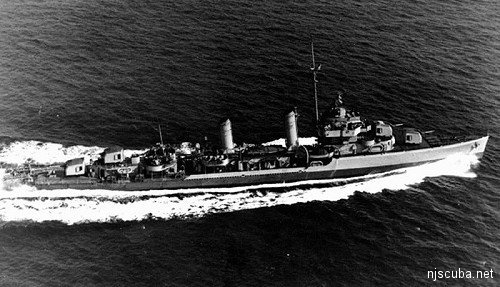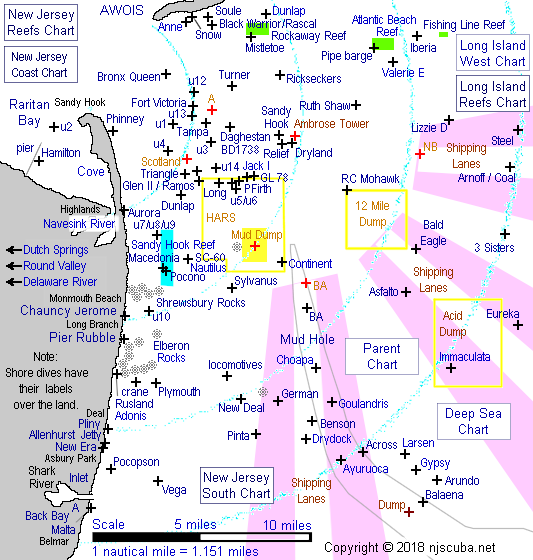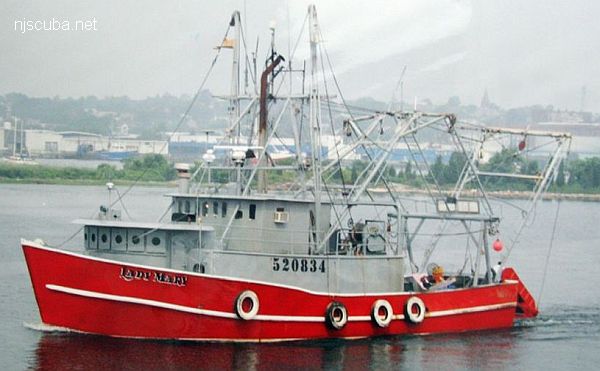USS Turner DD-648 (4/4)
The USS TURNER GOES DOWN
By Lawrence Principato

Commander Henry Sollett Wygand Jr. of the U.S.S. TURNER never had a chance. Without warning a mysterious explosion ripped open the main deck sending it sky-high, toppling the mast onto the deckhouse and smashing the ship's only link with the world, destroying the ship's nerve center and the emergency transmission radio system. Commander Wygand along with many of his officers were killed immediately. Sailors were blown to the deck. Their bleeding bodies were scattered everywhere. Fire erupted instantly while the engine room quickly filled with hot poisonous smoke and fumes.
As the wheelhouse collapsed it was accompanied by an unbearable screech of grinding steel. Many more seaman were blown over the side into the freezing water. The engineers feverishly worked to maintain power in subdued darkness waiting for orders from the bridge. Orders never came.
It was 3:30 A.M., January 3, 1944 when the Turner quietly maneuvered through the wind, rain and sleet in darkness, and dropped anchor, after completing nine months of active sea duty in the North Atlantic. Here she was 4 miles SE of Rockaway Point, Long Island in 60 ft of water awaiting new official orders.
This Bristol Class Navy Destroyer ( designated DD648 ) was one of 56 that were built in Federal Shipyards' facility in New Jersey. It was named in honor of Captain Daniel Turner, a hero of the war of 1812. It took five months to build, a record time even with today's automated shipbuilding techniques. This fortress could make in excess of 33 knots with her twin-screw machinery.
Chief Machinist Mate Rene H. Pincet was getting the engine room tuned up so that the Turner could weigh anchor at 7AM sharp. He was lighting off the boiler and getting ready to start up on time when suddenly and without warning a thunderous explosion violently shook the destroyer. "The concussion threw me across the engine room against the bulkhead", he recalled.
All communications were now useless and he couldn't talk to the bridge. The engine room quickly filled with smoke and toxic gases. "I secured the blowers hoping that would slow the smoke from coming down. We were busy. At the time there were six of us in the engine room, " he explained.
Dave Merrill, the radioman tried to send an SOS through the emergency transmitter but found the main radio room useless and in shambles. Later he said that what bothered him most was, "The loss of a brand new suit of tailor made blues ... They cost me $49."
The first blast ripped the 5 inch guns out of their mounts like they were toys. Sailors watched in awe and disbelief as the cannons turned end over end. Flames belched suddenly from another gun mount. Coxswain Raymond 0. Pomp said that his crew immediately broke out the C02 extinguishers to put out the flames erupting from #3 mount. When that extinguisher emptied they hooked up the hose. "We were especially concerned in preventing the gun's ammunition nearby from exploding, " he explained. "All hands were either fighting fire or taking care of some of the guys that got hurt. I heard three blasts in all. There was no confusion, no panic, even when the fuel oil flared up and lit up the stormy winter sky. The way the flames reflected on the rolling waves was weird. It was real scary with the artillery shells exploding around us."
Luckily the crew left the forward mess room a few minutes before the initial blast. That's where without any warning whatsoever the explosion tore open a gigantic hole. As with most meals of the day, the 200 crewmen were always fed in shifts and the engineers had just finished when it all happened. The engineers worked continuously to maintain enough pressure to operate the ship's fire water main. It was difficult groping in the semi-darkness, choking and trying to see through blood-shot eyes. The crew heroically remained at their posts attending to stricken buddies in the brightness of the burning fuel oil.
Coxswain Williams on duty at the Coast Guard look-out station on Sandy Hook luckily happened to see the destroyer explode through the haze. A general quarters alarm dispatched a sub-chaser and a 77 foot launch to the scene. The need for assistance spread quickly. Immediately upon arrival the Cutter rescued a man bobbing about on a torn mattress while another clung desperately to the ship's mascot, a little mongrel terrier called "Turn To."
Survivors were certain the order to 'abandon ship' came from the Cutter's Captain at 7AM. The 83 foot sub-chaser, the larger of the vessels, pushed her bow athwart the burning destroyer and lashed in to receive the stranded seamen. The bright flames of burning oil made the operation easier to see, while other Coast Guard units continued to cruise the area in search of missing Sailors.
Officially the cause of the mysterious explosion was blamed on defective ammunition. This explanation doesn't ring true simply because the experienced and well disciplined crew would have been alerted to any sensitive munitions problem during the previous nine months they worked together. A more popular theory attributed the blast to U-boat activity. It was a well known fact that Germans had sunk dozens of ships in and about New York harbor. The heavy blustery weather that blanketed the morning of January 3, 1944 could have provided enough cover for a sub to prowl in releasing numerous torpedoes to create the havoc witnessed on the Turner.
A normal compliment on destroyers of this class consisted of approximately 200 men. Of that number 163 were actually rescued. Its logical to presume that 37 men joined Commander Wygand on the "missing-in-action" list.
Ashore, reports later revealed, That the explosion affected people in a variety of ways. Besides the concussion and spooky whistling, gusts were accompanied by unexplainable rumbles that mysteriously rattled and shattered windows. Some thought it was an earthquake. Directly west of where the Turner exploded, covering the entire length of Staten Island's 15 miles, the countryside residents were bewildered and confused. In the Bay Ridge section along the waterfront, a woman was sure that "The heavy woman upstairs fell out of bed." Suburban dwellers thought their oil burners exploded. Up and down the New Jersey and Long Island shores and as far away as Bellville, New Jersey, folks reported strange happenings. Even in Bayshore and Babylon on Long Island, reports came in that people felt the explosion's vibration too.
Before everyone left the Turner Coxswain Ray Pomp went below decks, closed some hatches and checked to see that every one was out. "The next explosion I heard split her in two. That's when she busted-up after 7AM. Slowly the Turner slid to the bottom 55 ft down, " he sadly remembered. Just as the whirlpool of the sinking ship leveled off, the final and worst detonation occurred. Water flew high in the sky as if to say farewell. With daylight the ocean resumed its repetitive earthly pattern. The U.S.S. Turner is no longer a hazard to navigation since an oil tanker rubbed her bottom on the wreck. This prompted some salvage and the Turner now rests broken up in 50 to 58 ft of water. Although the Navy Department did not officially say so, German U-boats had been lurking around Coney Island area looking to decimate more tonnage as freighters left New York harbor for Europe. There is no doubt that German U-boats torpedoed the Turner not once but twice. Now she is an excellent in-shore search area, within easy reach for both divers and anglers. Bonito, albacore and weakfish have made the Turner their territory and roam about the old girl's slowly rusting remains. On a good day fishermen can be seen trawling for the big ones while nearby the red orange flag with the diagonal white stripe floats triumphantly nearby signifying ...Caution Diver Below.



Questions or Inquiries?
Just want to say Hello? Sign the .